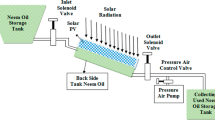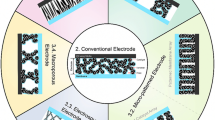Abstract
Thermochemical heat storage is a promising energy storage method and has received much attention in recent years. To improve the design and application of such systems, a better understanding of the characteristics of thermochemical heat storage is required. In this study, we analyze the heat release characteristics of thermochemical heat storage considering various operating parameters, such as charging temperature, humidity, and material. Three different thermochemical materials are considered herein, namely, zeolite 13X, zeolite 5A, and silica gel. The temperature profile at the inlet and outlet of the storage chamber, and that inside the chamber packed with thermochemical material, were measured. The pressure drop across the chamber was measured as well. The results indicate that the heat release characteristics change with position and time. Furthermore, the temporal curves of released heat are significantly affected by charging temperature and humidity. Zeolite 13X rapidly released a large amount of heat within a short period of time, whereas silica gel gradually released a small amount of heat, over a longer duration of time. The pressure drop across the chamber was found to vary with the bead size of the thermochemical material. Thus, the operating parameters including charging temperature, humidity, and material, have a significant effect on the characteristics of heat release. The data obtained herein can serve as a reference for the design of thermochemical storage systems.
Similar content being viewed by others
Abbreviations
- C p :
-
Specific heat of working fluid (kJ/kg-K)
- m :
-
Mass flow rate (kg/s)
- Q r :
-
Amount of released heat (kJ)
- Q o :
-
Amount of heat at outlet (kJ)
- Q i :
-
Amount of heat at inlet (kJ)
- T:
-
Temperature (K)
- t :
-
Time (s)
- t f :
-
Final time (s)
- t i :
-
Initial time (s)
References
D. Lee and C. Kang, A study on development of the thermal storage type plate heat exchanger including PCM layer, Journal of Mechanical Science and Technology, 33(12) (2019) 6085–6093.
V. Sun, A. Asanakham, T. Deethayat and T. Kiatsiriroat, Increase of power generation from solar cell module by controlling its module temperature with phase change material, Journal of Mechanical Science and Technology, 34(6) (2020) 2609–2618.
N. V. Cao, X. Q. Duong, W. S. Lee, M. Y. Park, J. D. Chung and H. Hong, Effect of heat exchanger materials on the performance of adsorption chiller, Journal of Mechanical Science and Technology, 34(5) (2020) 2217–2223.
N. Yu, R. Z. Wang and L. W. Wang, Sorption thermal storage for solar energy, Progress in Energy and Combustion Science, 39 (2013) 489–514.
L. Scapino, H. A. Zondag, J. V. Bael, J. Diriken and C. C. M. Rindt, Sorption heat storage for long-term low-temperature applications: a review on the advancements at material and prototype scale, Applied Energy, 190 (2017) 920–948.
J. Li, T. Zeng, N. Kobayashi, H. Xu, Y. Bai, L. Deng, Z. He and H. Huang, Lithium hydroxide reaction for low temperature chemical heat storage: hydration and dehydration reaction, Energies, 12 (2019) 3741.
S. R. Clark, A. Mehrabadi and M. Farid, State of the art on salt hydrate thermochemical energy storage systems for use in building applications, Journal of Energy Storage, 27 (2020) 101145.
K. Lim, J. Che and J. Lee, Experimental study on adsorption characteristics of a water and silica-gel based thermal energy storage (TES) system, Applied Thermal Engineering, 110 (2017) 80–88.
K. Johannes, F. Kuznik, J. L. Hubert, F. Durier and C. Obrecht, Design and characterisation of a high powered energy dense zeolite thermal energy storage system for buildings, Applied Energy, 159 (2015) 80–86.
R. Alebeek, L. Scapino, M. A. J. M. Beving, M. Gaeini, C. C. M. Rindt and H. A. Zondag, Investigation of a household-scale open sorption energy storage system based on the zeolite 13X/water reacting pair, Applied Thermal Engineering, 139 (2018) 325–333.
M. Gaeini, R. Alebeek, L. Scapino, H. A. Zondaga and C. C. M. Rindt, Hot tap water production by a 4 kW sorption segmented reactor in household scale for seasonal heat storage, Journal of Energy Storage, 17 (2018) 118–128.
S. P. Casey, D. Aydina, S. Riffata and J. Elvins, Salt impregnated desiccant matrices for ‘open’ thermochemical energy storage-hygrothermal cyclic behaviour and energetic analysis by physical experimentation, Energy and Buildings, 92 (2015) 128–139.
D. Mahon, P. Henshall, G. Claudio and P. C. Eames, Feasibility study of MgSO4 + zeolite based composite thermochemical energy stores charged by vacuum flat plate solar thermal collectors for seasonal thermal energy storage, Renewable Energy, 145 (2020) 1799–1807.
S. J. Kline, The purposes of uncertainty analysis, Journal of Fluids Engineering, 107 (1985) 153.
J. Cejka, H. Bekkum, A. Corma and F. Schueth, An Introduction to Zeolite Science and Practice, 3rd Revised Ed., Elsevier, Oxford, U.K. (2007).
Author information
Authors and Affiliations
Corresponding author
Additional information
Sung Kook Hong received the B.S. and M.S. degrees in mechanical engineering from Chung-Ang University, Korea in 1998 and 2000; the Ph.D. from Yonsei University, Korea in 2007. He is currently Principal Researcher at Korea Institute of Energy Research. His research interests include heat transfer problems at various energy systems such as thermal energy storage, heat exchanger, and gas turbine.
Rights and permissions
About this article
Cite this article
Hong, S., Lee, Jy., Lee, H. et al. Experimental study on heat release characteristics of thermochemical heat storage considering various operating parameters. J Mech Sci Technol 35, 779–784 (2021). https://doi.org/10.1007/s12206-021-0138-7
Received:
Revised:
Accepted:
Published:
Issue Date:
DOI: https://doi.org/10.1007/s12206-021-0138-7




